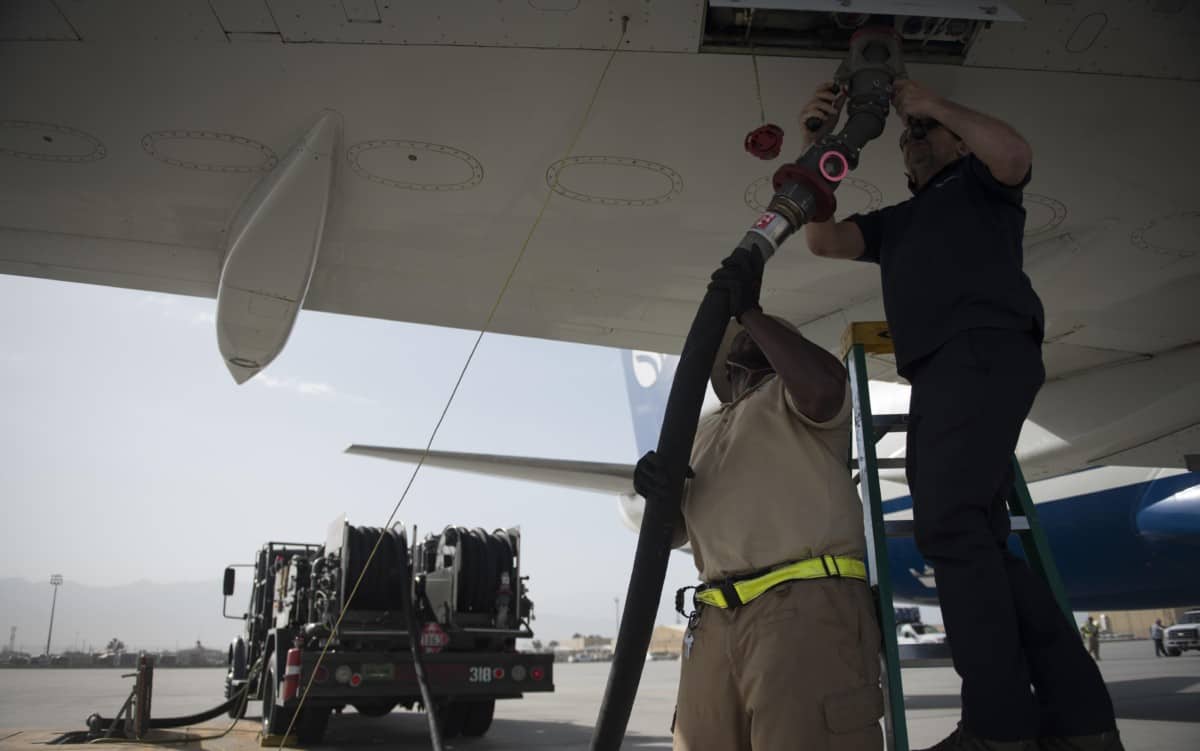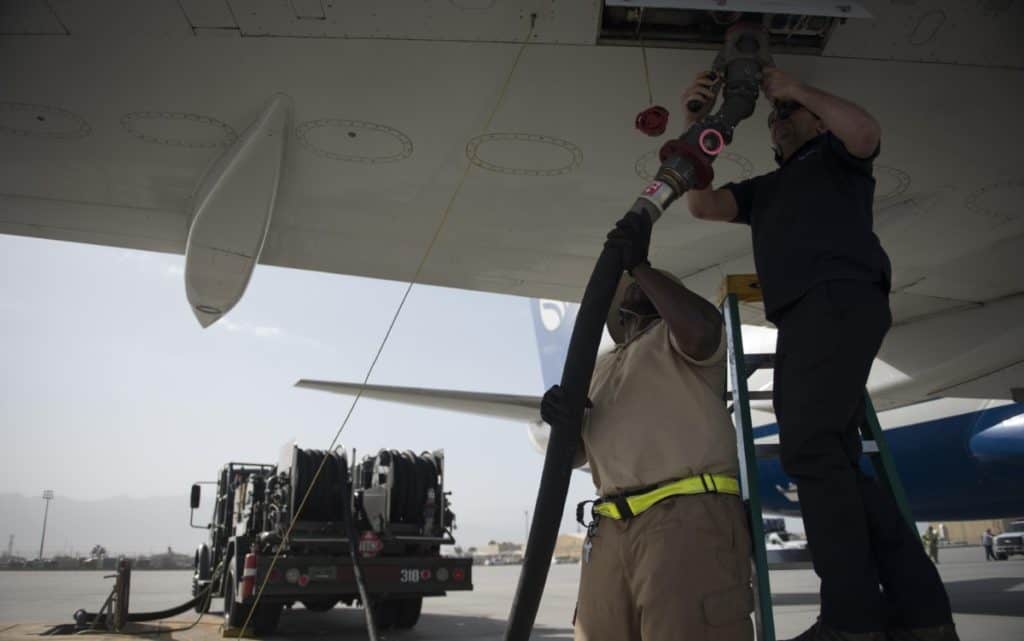
As soon as a large airliner pulls up to the gate the choreography of ground handing begins and one of the most noticeable pieces of equipment to show up is the fuel truck. The question is though, “How long does it take to refuel an airplane”? Sometimes there is just one fuel truck and other times there is a truck under each wing!
Airport fuel trucks usually refuel airplanes at around 300 gallons/1135 liters per minute. With one fuel truck, a Boeing 737 can be fuelled from empty in around 23 minutes. A Boeing 747 using two fuel trucks with dual nozzles in around 52 minutes. All planes are fuelled for the next flight only.
The larger the airplane, the more fuel it will need, and the larger its fuel tank capacity will be. Airport refuellers are given an allotted time to get the required fuel onboard and there are several tricks that they use to ensure they meet their deadlines!
Here are Some Refueling Times for 15 of the Worlds Most Common Airplanes:
| Airplane | Fuel Capacity US Gal | 1 Truck Single Nozzle 300GPM | 1 Truck Dual Nozzles 600GPM | 2 Trucks Dual Nozzles 1200GPM | Typical Fill Time If Tanks Already @ 15% | Cost To Fill Aircraft USD |
|---|---|---|---|---|---|---|
| Antanov AN-225 | 98,656 | 5h 30min | 2h 45min | 1h 23min | 1h 10min | $493,280 |
| Airbus A380 | 85,472 | 4h 44min | 2h 22min | 1h 11min | 60min | $427,360 |
| Boeing 747-8 | 63,034 | 3h 30min | 1h 45min | 53min | 45min | $315,170 |
| Boeing 777-200LR | 47,890 | 2h 40min | 1h 20 min | 40min | 34min | $239,450 |
| Airbus A350-1000 | 41,948 | 2h 20min | 1h 10min | 35min | 30min | $209,740 |
| Boeing 787-10 ‘Dreamliner’ | 33,384 | 1h 51min | -** | -** | 47min | $166,920 |
| BAC Concorde | 31,483 | 1h 44min | – | – | 45min | $157,415 |
| Airbus A320 | 7,190 | 24min | – | – | 20min | $35,950 |
| Boeing 737 Max | 6,853 | 23min | – | – | 19min | $34,265 |
| Airbus A300 ‘Beluga’ | 6,303 | 21min | – | – | 18min | $31,515 |
| Dassault Falcon 6X | 5,042 | 17min | – | – | 14min | $25,225 |
| Gulfstream G500 | 4,514 | 15min | – | – | 13min | $22,575 |
| Embraer CRJ1000 | 2,902 | 10min | – | – | 8min | $14,510 |
| Bombardier Q400 | 1,724 | 6min | – | – | 5min | $8,620 |
| Cessna Citation V | 861 | 3min | – | – | 3min | $4,305 |
| Beechcraft 1900D | 665 | 14min* | – | – | 11min | $3,325 |
Table data based on filling each aircraft from empty to full. Most aircraft arrive with reserve fuel remaining in the aircraft from their previous flight (typically around 15% of its capacity).
* Beechcraft 1900D is not equipped to refuel using the 300GPM High-Pressure underwing refueling system. Instead, it is fueled using a hose and nozzle to an overwing filler port with a maximum of 50GPM.
** Aircraft with only one refueling point available and only a single nozzle connection.
How are Airplanes Refueled?
Airplanes are fueled using either a high-pressure, sealed delivery hose at 300 gallons/1135 liters per minute or a hose and nozzle to an open filler port at 50 gallons/190 liters per minute. Some fuel trucks have dual high-pressure filling nozzles for faster airplane fuelling.
Airlines have strict turnaround times for their aircraft as they only make money when they are flying. The faster they can get a plane unloaded, reloaded, and back in the air, the more money they make.
To do this efficiently the airplane manufacturer creates a guide for the turnaround for each of its aircraft. Within this guide, they show the following diagram for their Boeing 747-8 on the positioning of ground support vehicles:
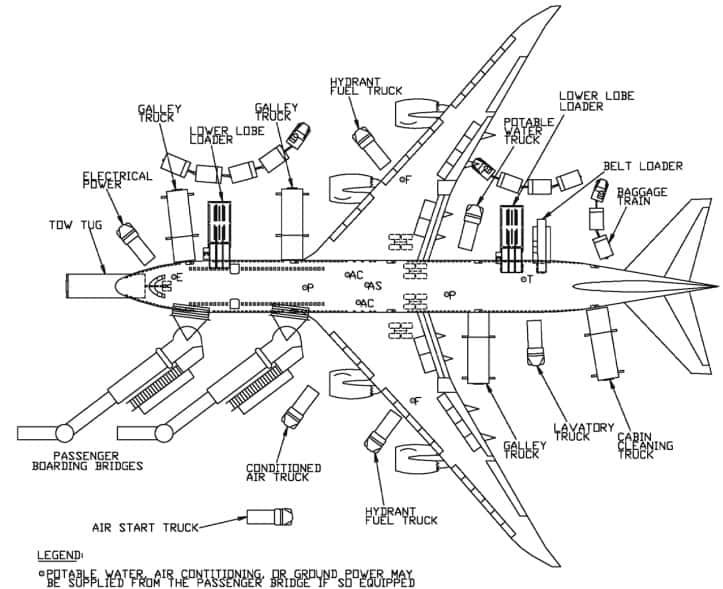
To further increase efficiency they also issue a timeline to help the airlines prep for a 747-8’s arrival and turnaround:
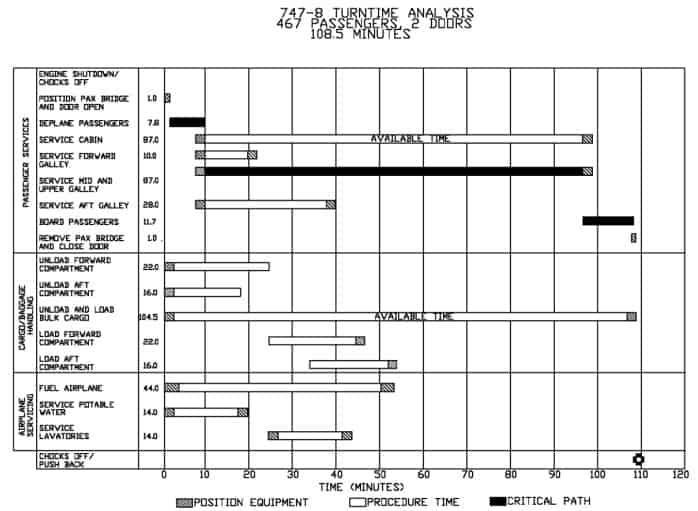
If you notice on the time planner Boeing has allotted 44 minutes to refuel the airplane. This is using two trucks as denoted in the diagram above it too. If only one truck is available, you can see that there is still time to move the truck to the other wing refueling point and fuel for a further 44 minutes and still be within the timeline before passengers begin boarding.
Fuelling while passengers are onboard is avoided as much as possible due to the implications of a fire breaking out. Quickly evacuating cleaning staff and aircraft crew is much faster than an entire aircraft full of passengers.

Join My Newsletter & Get Great Tips, Information and Experiences To Help You Become a Superb Pilot!
Here are some of the ways airlines get their aircraft refueled as fast as possible:
Depending on the size of the aircraft there are two main delivery methods to get fuel into the aircraft and for getting the fuel from the storage farm to the aircraft there are also varying options:
Types of Fuel Delivery Systems:
Overwing Low-Pressure Delivery System
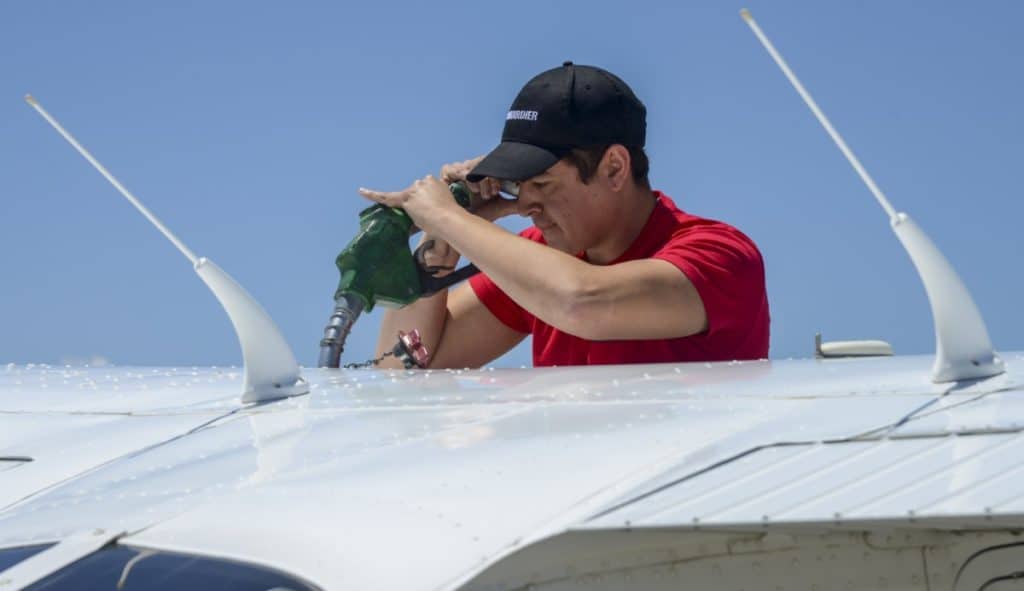
For aircraft with smaller fuel tanks, an overwing fueling point is the most common refueling point. There can be a filling point on the top side of each wing or just one single filling point for the entire aircraft, similar to your car.
This type of delivery system uses a hose with a nozzle to direct the flow of fuel into the aircraft and will be fed at a maximum flow rate of 50 gallons or 190 liters per minute. This is how all light aircraft like Cessnas and Cherokees are refueled.
Underwing High-Pressure Delivery System
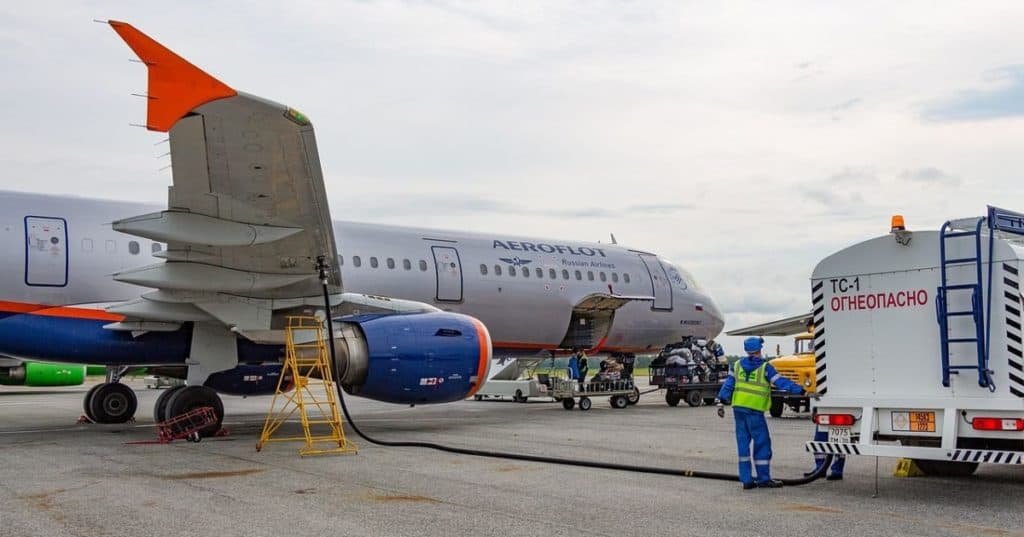
For airplanes that require a large volume of fuel for each flight, they use a high-pressure fuel delivery system that connects to the fuel truck via an underwing filling nozzle. These systems allow much faster delivery of 300 gallons or 1135 liters of jet fuel every minute.
The nozzle on the end of the refueling hose connects via a push and lock fitting to allow the refueler to not have to stand there and hold the hose into the filler cap – Good job because the hose diameter, the volume of fuel in the hose, and the nozzle its self can become very heavy during the fill!
Many aircraft will have a fuel intake connector on the underside of each wing or smaller and newer aircraft will have just one intake under the right wing and fill all the tanks from that one location. The larger the airplane, the more fuel intake connectors it will have – More on this later.
Mobile Fuel Tanker Truck
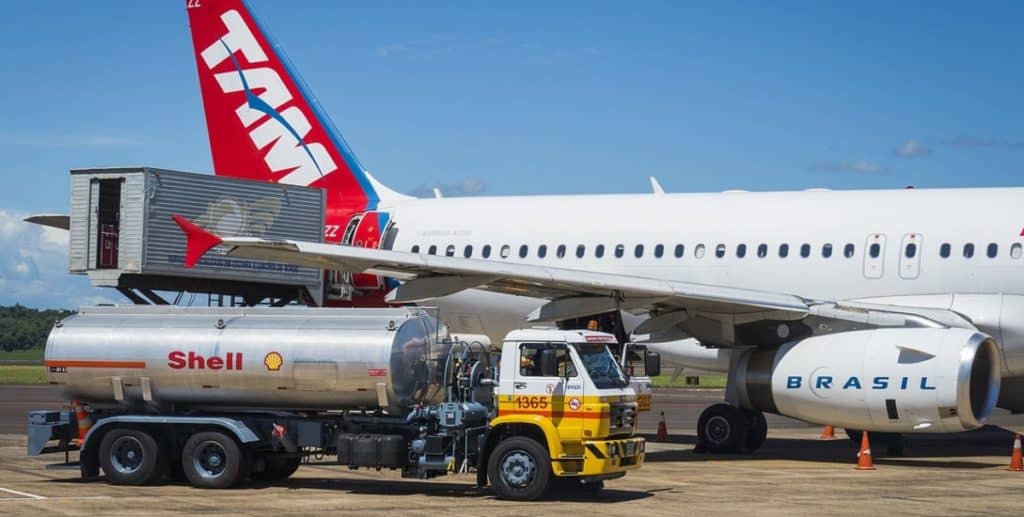
To get the fuel to the airplane the easiest way is via a mobile tanker truck. These trucks can range in size from 1,000 gallons for small airports, up to monstrous 15,000 gallon mobile gas stations. The fuel trucks that are located at small airports will usually be fitted with hoses to deliver fuel using both the high and low-pressure systems to accommodate all aircraft operating from that airport.
For the large, international airports most of the fuel trucks will be of large volume and only dispense using the high-pressure delivery system. There is one problem with the mobile fuel trucks – Even the biggest truck, holding 15,000 gallons of jet fuel is unable to supply enough fuel to fill the largest aircraft!
Multiple fuel trucks would be needed to supply just one large aircraft which is not efficient. This is why most large airports use the Hydrant Fuel Delivery System.
Hydrant Filler Truck
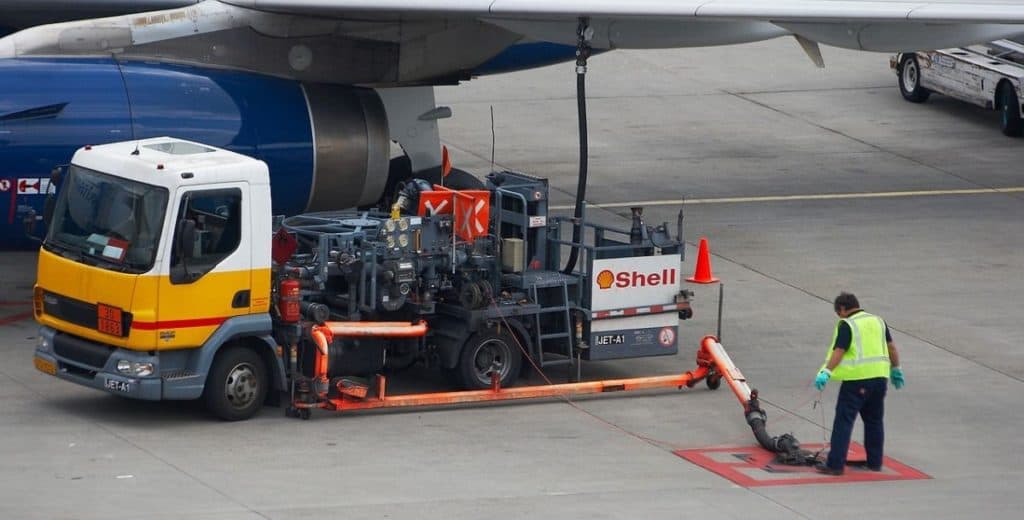
The most economical way to fill an airplane like a Boeing 747 or an Airbus A380 is to have the fuel supply available at the gate. Under the airport lies a vast network of 18″-24″ fuel pipes. Rising up off this network are 6″ pipes that place a fuel connection point under the wing of each airplane parked at the gate – These are known as Hydrants.
These hydrants are fed directly from the airport’s colossal fuel farm which is located off to the side of the airport. Providing there is fuel in the fuel farm, there will be fuel available at every gate. Each hydrant is able to supply fuel at a rate of between 600GPM – 1,000GPM (2270LPM – 3785LPM)
To get the fuel from the Hydrant connector to the aircraft, the refueling department uses a Hydrant Filler Truck. When connected, this truck filters and measures the fuel to enable rapid filling of the airplane without the worry of running the tank dry.
# of Fueling Nozzles
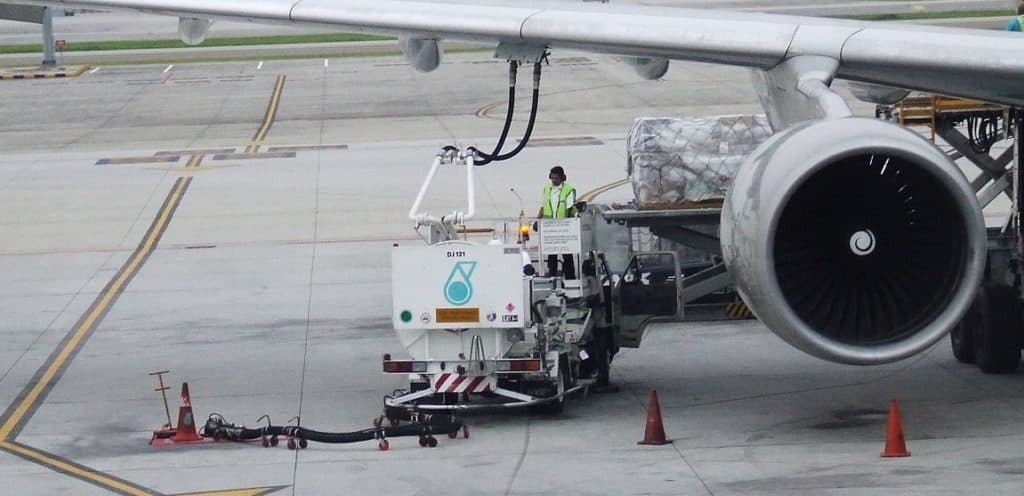
To get an aircraft the size of a Boeing 747 or an Airbus A380 refueled within the allotted timeframe a single filling point may not be enough. To aid in this dilemma, the aircraft manufacturers designed the refueling stations on their airplanes to have two input nozzles under the wing.
This allows a fill rate from one hydrant truck to double to 600GPM.
If even the largest aircraft are completely void of fuel when they arrive (which they won’t be!), a fuel delivery of 600GPM would fill the biggest aircraft to capacity in around 2 hours. This is still not fast enough to meet the 44 minutes allocated for a Boeing 747, so another trick is required.
# of Fuel Trucks
When a single fuel truck is still not fast enough, a second hydrant truck can be hooked up to another fuelling station under the other wing providing a further 600GPM bringing the total refueling flow rate to 1,200GPM. Now the largest aircraft can be filled from practically empty to full capacity in around an hour.
All aircraft will arrive with a reserve and unused fuel remaining in their tanks, this could be anywhere from 10-30% of its total capacity. The second factor is that fuel costs money to transport on the airplane so excess fuel is never really taken. There is enough for the calculated reserves and diversions, but after that extra fuel is a money waster.
The final factor is that a lot of aircraft are unable to take a full passenger and cargo load as well as full-capacity fuel. By doing this it would place the aircraft over its Maximum Gross Takeoff Weight. Airline planners and pilots will calculate the maximum amount of fuel required for the next leg and give that volume to the refueler.
An aircraft may arrive with 20% of its fuel capacity remaining and then only require being topped up to 90%. For an airplane like a Boeing 747-8 this could mean a total fuel upload of 70% of its total capacity = 44,125 gallons required.
Using two hydrant trucks with dual nozzles means the time to fill would be around 36 minutes.
Further Reading
If you found this article helpful here are a few more you may enjoy:

